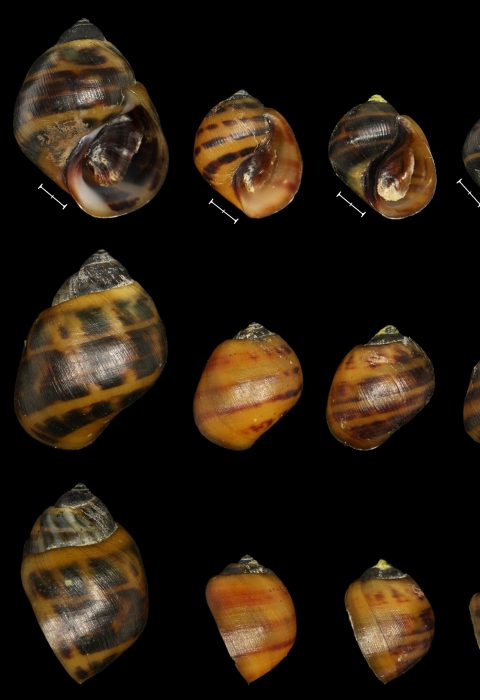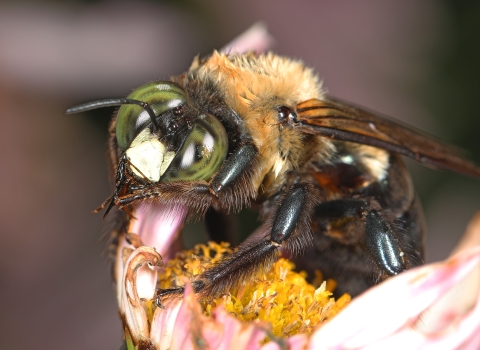Calhoun County, Alabama — Biologists Nathan Whelan and Paul Johnson weren’t sure what they’d find when they launched their boat on that balmy Alabama morning. Whelan, a biologist currently serving as the U.S. Fish and Wildlife Service’s regional geneticist for the Southeast Region, was updating a scientific manuscript on the painted rocksnail, and needed the most recent information on its current range.
The painted rocksnail is a rather cryptic-looking small-to-medium sized freshwater snail with yellowish-brown coloring. The shell is oval-shaped with four dark bands on the exterior. Found only in Alabama, the snail needs clean, flowing water to survive. Historically, you could find it throughout much of the Mobile River Basin in the Alabama and Coosa Rivers, as well as the Cahaba River. Unfortunately, the painted rocksnail has disappeared from 90 percent of its range and was listed as threatened under the Endangered Species Act in 1998. Biologists say the species faces multiple threats.
“The biggest historical threats are dams. That’s why the range is so restricted,” explained Whelan. “Current threats include the continued impoundment of the reservoirs on the Coosa River, agricultural run-off, and barriers between populations, which restrict gene flow.”
“The large dams ended-up submerged and fragmented the best available habitats within the entire Coosa River basin,” added Johnson, director of the Alabama Aquatic Biodiversity Center with the Alabama Department of Conservation and Natural Resources. “As a result, the largest population of the rocksnail was essentially ‘removed’ from the Coosa River all together, only leaving behind smaller, more fragmented populations in only a few of its tributaries.”
In an effort to improve communication and conservation efforts for the species, biologists launched a massive effort to reassess the identity and historical range of the painted rocksnail. The study took time, but validating the species’ true identification was vital to its management and conservation efforts.
“These studies and efforts can be rather intense, requiring a combination of biological (laboratory research) and an investigation of historical museum collections to help determine the historical distribution,” explained Johnson.
Mistaken identity
Now, the species faced another problem.
While reassessing the species, biologists discovered the painted rocksnail was actually misidentified when it was first discovered by Timothy A. Conrad in 1834. This meant the species’ range was even smaller than originally thought.
“It looks like the original author [Conrad] had mistakenly described a juvenile spotted rocksnail, which looks very similar, as the painted rocksnail,” explained Johnson. “It’s only taken us now 183 years to correct the mistake, and rename the species Conrad originally described in 1834, as *Leptoxis coosaensis*… a new scientific name!”
It was imperative that Whelan and Johnson do everything possible to see if more populations were out there. Both believed Ohatchee Creek, a tributary of the Coosa River, would be a good place to start.
“We weren’t aware of anyone who had collected the species there for more than 20 years. But we were also not sure if anyone had really looked,” explained Whelan.
According to local and museum records, Ohatchee Creek hasn’t seen a painted rocksnail since October of 1992. Could there possibly be a new population?
The two scientists launched just below Neely Dam and motored up to the first big shoal. This wasn’t Johnson’s first rodeo. As director of the Alabama Aquatic Biodiversity Center, he’s arguably one of the state’s, if not the nation’s, most respected authorities in aquatic species and their habitats. “I’ve been doing this for so long, I know where to look!” said Johnson.
It didn’t take long for the biologists to strike gold.
“I found them within five seconds of putting my hands in the water,” explained Johnson. “They were attached to the first rocks I picked up!”
“Pretty much as soon as we got out of the boat, we were picking up rocks with painted rocksnails on them,” said Whelan. “To be honest, I was rather surprised. We found a lot in the small stretch of river we sampled.”
What does the discovery mean?
Although the newly discovered population is some much-needed good news, the painted rocksnail still has to overcome many obstacles before coming off the Endangered Species list.
“Whenever the existence of an overlooked population of a threatened [or endangered] species is confirmed, it’s good news for the species,” said Whelan. “Now that we know the snails are in Ohatchee Creek, we can take that into consideration when making management decisions. This population may also serve as an ideal broodstock broodstock
The reproductively mature adults in a population that breed (or spawn) and produce more individuals (offspring or progeny).
Learn more about broodstock population for captive propagation and reintroduction efforts But we have to remember the species is still gone from more than 90% of its range, and still faces many threats to its survival.”
“The rediscovered population is small and rather perilous. There’s no immediate, specific threat. There’s just not many snails over a very large area, which makes that population more vulnerable to extirpation,” said Johnson.
Lessons learned
Alabama Field Office assistant supervisor Jeff Powell says the discovery teaches biologists to keep an open mind when looking for a species. He says it’s important for researchers to consider all possibilities before ruling out a site.
“Just because a species once occurred in a particular location doesn’t necessarily mean it will remain there, and likewise, just because a species was not known from a particular location twenty years ago doesn’t mean it’s not there now,” said Powell. “We’ve seen this over and over with rare aquatic species that we thought we understood. We also have to consider conducting surveys during multiple times of the year. Some species like the Alabama pearlshell and trispot darter are only detectable when they’re spawning, which might only be a few weeks out of the year. If you’re not there in this sometimes very short window, you could easily miss them all together.”
Biologists have high hopes for the future of aquatic species. Although Alabama has the most imperiled water species in the nation, multiple partnerships continue to break new ground in conservation. Through the Alabama Rivers and Streams Network, several stakeholders are forming strategies to reduce environmental threats to aquatic species. At the same time, biologists are always looking for suitable habitats and willing landowners to reintroduce imperiled species that are being grown by Johnson at the Alabama Aquatic Biodiversity Center.
“In Alabama, we are blessed with an abundance of biodiversity … particularly aquatic species. With the help of our partners, including private landowners, foresters, and industries, we have big plans in store for 2018 and beyond,” said Powell. “The discovery of this population is only the beginning of great things to come.”
Contact
Denise Rowell, Public Affairs Specialist in Alabama
denise_rowell@fws.gov, (251) 441-6630



